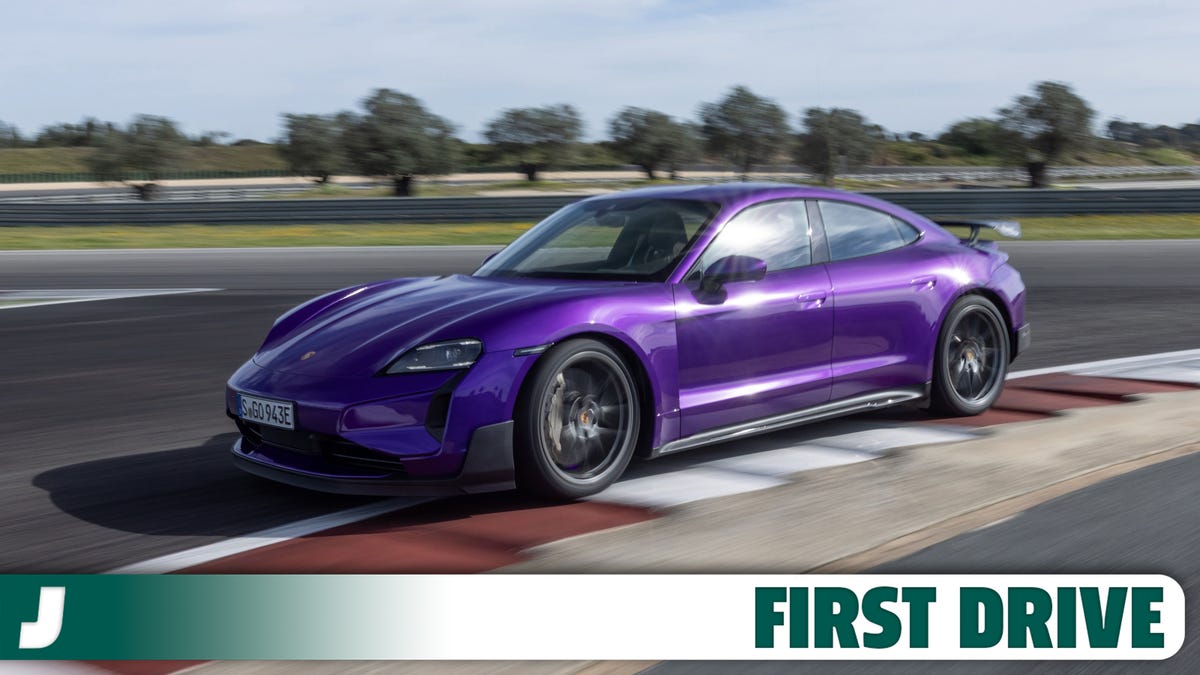Driving a car with more than 1,000 horsepower can be a bit nerve-wracking, a feeling that would seemingly be compounded if your first experience with it is on a race track you’ve never driven on before. But as I’m lapping Circuito Monteblanco near Seville, Spain in the 2025 Taycan Turbo GT, Porsche’s first attempt at an electric production car that’s engineered for on-track prowess, what strikes me is just how easy the electric sedan is to drive confidently. It feels mega quick, of course, but instead of being daunting it’s encouraging and exciting.
The Turbo GT has already set lap records at Laguna Seca and the Nürburgring that are not only impressive for an EV, but better than many benchmark internal combustion production cars and race cars. The fact that it’s a heavy electric sedan just adds on to how impressive its performance is, and that’s part of what makes the Turbo GT such a satisfying car. Porsche uses complex technology to enhance the Taycan’s driving experience without taking away from the qualities that make people love Porsche’s track-oriented GT products, resulting in a car that’s deserving of the badge.
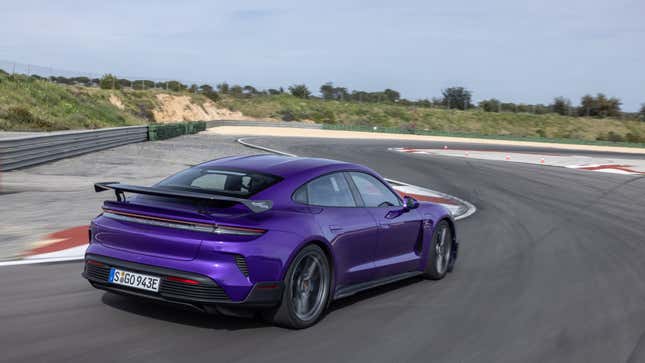
Full disclosure: Porsche flew me to Spain to drive the 2025 Taycan lineup, with the standard Taycans used for the on-road portions and the Turbo GTs being relegated to the race track. I ate great food and slept in a room that had a wonderful view of Seville, but rewatching “Mission: Impossible – Dead Reckoning” on the plane ride home was probably the best part of the trip.
Now, the Turbo GT doesn’t always make that full 1,019 horsepower. In normal driving it has 777 hp and 855 pound-feet of torque, with the max 1,019 hp and 988 lb-ft coming online when using launch control or Attack Mode — more on the latter in a bit. That’s a not-insignificant increase over the refreshed Taycan Turbo S, which puts out 764 hp and 722 lb-ft normally or 938 hp and 818 lb-ft with launch control.
Unlike competitors from Tesla and Lucid, Porsche hasn’t gone with a tri-motor setup, instead sticking with one electric motor at each axle. To achieve the higher output, the Turbo GT has the same larger 105.0-kWh battery pack and bigger rear-axle motor as the other 2025 Taycan models, plus a unique pulse inverter made from more efficient silicon carbide. The Turbo GT’s inverter has a 900-amp current, an increase of 300 amps over a Turbo S, and the two-speed transmission’s ratio has also been revised.
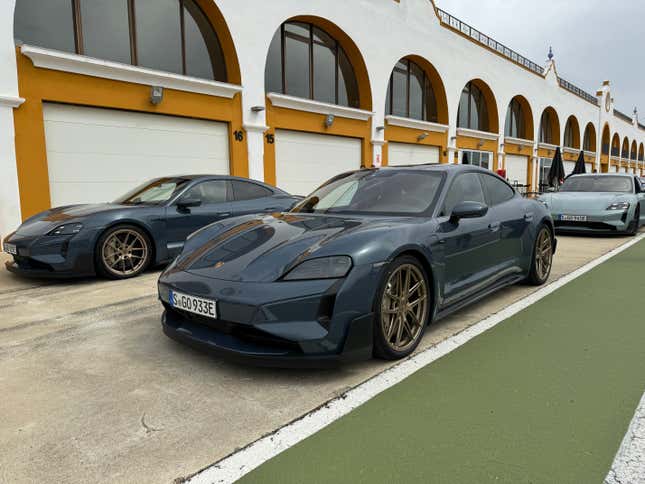
So people know you’re not just driving a normal Taycan, the Turbo GT has a unique aero package and other specific design details. There’s a new front splitter with a lower air dam, thick aero blades ahead of the front wheels and aft of the rear wheels, a Gurney flap on the active rear spoiler, and a deeper rear diffuser. Add the Weissach Package, a no-cost option, and you get a fixed carbon-fiber rear wing, underbody air deflectors and functional front fender vents. Other visual changes include Victory Gold brake calipers, lightweight 21-inch wheels and lots of black and carbon-fiber trim. Purple Sky Metallic is a new color that’s absolutely glorious, and you also can and should spend $11,400 on an awesome bright blue full-body wrap.
We go out on track three at a time, with one of Porsche’s drivers leading in a Taycan Turbo S sedan, and then two journalists following in tandem, swapping between second and third place halfway through our session of eight laps. I start out in the middle car, a “standard” Turbo GT in Pale Blue Metallic. Like all other Taycans, the Turbo GT is excellent from the moment I set off. The steering is laser sharp and full of feedback, and the rear-axle steering and brake-based torque vectoring are seamless. It’s easy to make quick, minor corrections without the car getting unsettled. The Taycan has a real sports car–like seating position and view out, and you sit really low to the ground — the tradeoff is a fairly cramped cabin and compromised storage space.
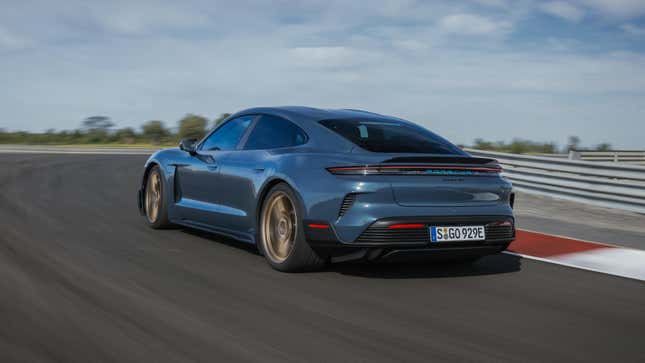
Taking up the first third of the main straight, Porsche set up a slalom course with cones that we tackle at about 45 mph, after which we come to a stop between a pair of cones to test out launch control. Porsche launch control is among the easiest launch control systems to operate — you just need to be in the sportiest drive mode, put one foot on the brake and then press down the accelerator, and then release the brake. The Turbo GT will hit 60 mph in a scant 2.2 seconds, a tenth quicker than a Turbo S, and it does it with zero drama. There’s no wiggle under acceleration or even a millisecond where the tires are scrambling for traction — the Taycan just slightly hunkers down and rockets ahead. Even having driven cars like the Lucid Air Sapphire and Rimac Nevera that have 0-to-60 times in the sub-2-second range, the Turbo GT’s acceleration takes my breath away.
Where I really notice the Turbo GT’s additional power is above the 60-mph mark. It takes just 6.6 seconds to reach 124 mph from a standstill and the quarter-mile is accomplished in 9.5 seconds, 1.1 seconds and 0.4 seconds quicker than a Turbo S, respectively. The transmission’s shift feels even more violent than in the Turbo S, too. After gaining confidence in the first couple runs, on our final launch control sprint I take a quick glimpse at the digital speedo just before braking for the first corner and see 130 mph, a staggering speed given the relatively short distance — the main straight at Monteblanco is just over half a mile long, and the Turbo GT reached that speed using just two-thirds of it.
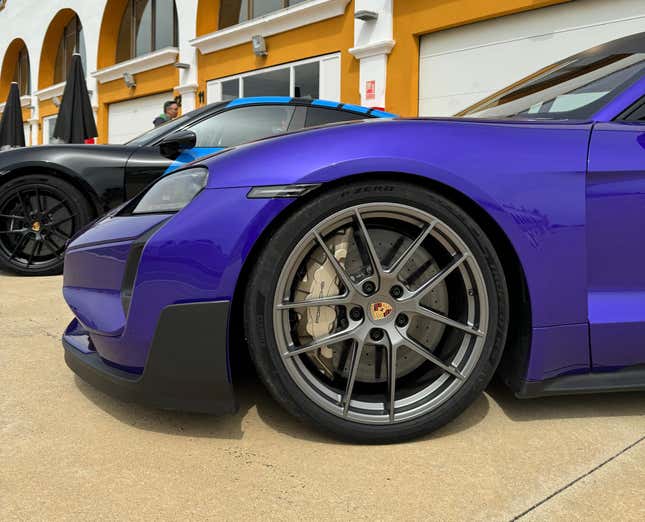
And man, are the brakes good. The Turbo GT has a new version of Porsche’s carbon-ceramic brakes that are more than four pounds lighter per corner and have better cooling, and every 2025 Taycan is now capable of 400 kW of energy recuperation through braking, an increase of over 30 percent. That added stopping power is really noticeable the harder I stomp on the brakes. The pedal itself is nice and firm and there doesn’t seem to be any fade after our hot laps, though the instructor does have us use the brakes as little as possible on the cool-down lap.
Porsche and Pirelli first started working together on the Turbo GT in 2021, with the Italian tiremaker developing new versions of the P Zero specifically for the 2025 Taycan. The standard tire is the P Zero R, while semi-slick street-legal P Zero Trofeo RS tires will be optional. I don’t get a chance to try out the Trofeos, but the P Zero Rs provide more than enough grip for my skill level and there’s not much squeal even under hard cornering.
Standard is Porsche’s new Active Ride suspension system, which has hydraulic motors in each active damper that act as anti-roll bars. Active Ride can individually control the flow inside each damper to instantly adjust compression and rebound. (Our friend Jason Fenske at Engineering Explained has a great video explaining exactly how it works that I’ve embedded above.) There’s one corner of the track that’s a blind right-hander with its apex at the crest of a hill, and it has more tarmac at the exit than it seems. Even carrying a lot of speed into the turn, Active Ride keeps the car flat and ensures that maximum force is being applied to each wheel at all times, so all four tires maintain their contact with the road through the entire corner — and with none of the stomach-lifting feeling you get doing an actual jump.
After coming back into the pits, the other journalist and I swap cars so I can experience the Weissach pack, and him the car without it. This Shade Green car has Porsche’s full bucket seats, which are offered in Europe but won’t be available in the U.S. — Porsche says they won’t pass crash tests. But U.S.-bound Weissach-pack Taycans delete the rear seats, with a carbon-fiber storage compartment and bulkhead in their place. Along with other weight-saving measures like reduced sound deadening, lighter glass and the omission of some power-operated features, the Weissach option makes the Turbo GT 157 pounds lighter than a Turbo S. All of the Weissach’s aero bits mean downforce is up to 485 pounds, too.

With the Weissach Package the Turbo GT is a tenth quicker to 60 mph, a tenth quicker in the quarter and two tenths quicker to 124 mph. Top speed is raised from 180 to 190 mph. In the real world the difference in speed is basically negligible, but the Weissach’s improved aero is apparent. It’s a bit less agile than the standard Turbo GT, but its cornering capabilities feel sharper. The cabin is also a lot louder, and I’m able to hear more of the cool legit powertrain noises — and Porsche’s toggleable spaceship-y noises, which I love.
Taking the place of the regular Taycan’s push-to-pass function is the Turbo GT exclusive Attack Mode, which is inspired by Formula E. Activated with a press of the button in the steering wheel’s drive mode dial or by pulling the paddle shifter that the Weissach models get, Attack Mode gives you a boost of 160 hp for up to 10 seconds, 66 hp more than what you get in a Turbo S. Better yet, Attack Mode can be used once every 4 seconds, versus once every ten seconds in a standard car. In the pre-drive briefing, Porsche shows us Lars Kern’s Laguna Seca lap record with an overlay showing exactly when, where and for how long he activated Attack mode — he did it 9 times, typically priming it mid-corner for maximum speed at exit.
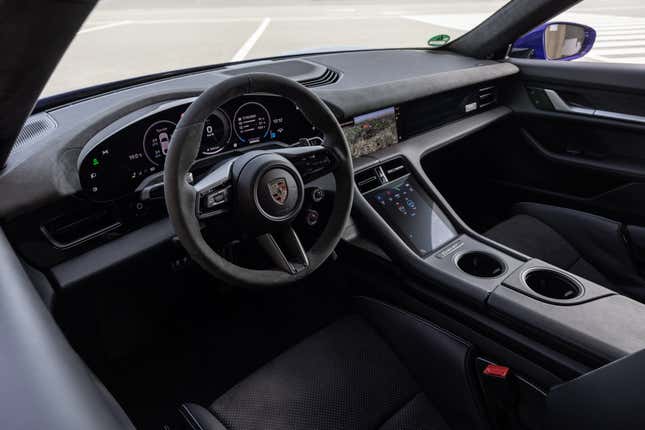
I don’t mess with it much on my first laps, partially because I’m just trying to focus on learning the track and being smooth and partially because the button can be annoying to hit quickly on the non-Weissach car. But in my few laps in the Weissach model, I’m more liberal with my use of Attack Mode, and it certainly makes a difference. The paddle has satisfying action to it, and the effect is immediate. It’s kinda like when Timotheé Chalamet drinks the worm juice in “Dune: Part Two” — suddenly his eyes glow blue and he’s a lot more powerful. When Attack Mode is activated, the Taycan’s gauge cluster displays a blue countdown ring. It’s basically the same thing.
While this brief stint isn’t enough to really eke out the advantages of the Weissach-equipped car, I think it’ll appeal to two different kinds people: Those who actually want to take their car to the track and be as fast as possible, and those who want to stunt on cars and coffee attendees and get more Instagram likes. For a lot of Porsche GT car owners, that venn diagram is a circle, and I’m all for both camps. Cars like the 718 Cayman GT4 RS and 911 GT3 RS see large majority percentages of buyers going for the Weissach packages, and even with the rear-seat delete I think the Taycan Turbo GT will be the same.
Not only will you happily want to drive the Taycan Turbo GT on track, you’ll want to drive it to and from the racetrack, too. This brief track drive has me itching to get a Turbo GT for a blast up my local mountain roads, and extra road noise aside, it’ll be just as nice of a road trip car as a regular Taycan. We don’t have final numbers yet, but the entire 2025 Taycan lineup has seen a 34-percent increase in range, and its fast-charging capabilities are faster and have an improved curve, even in cold weather. So you’ll be able to lap for longer, and spend even less time juicing up between stints.
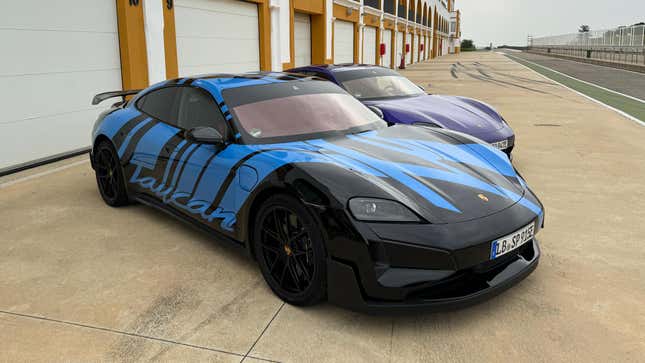
As with every other GT-branded Porsche, you’ll have to cough up a pretty penny to get your hands on a Taycan Turbo GT — it starts at $231,995 including destination, $21,000 more than a Turbo S, and it can reach around $290,000 fully loaded. $250,500 will get you a Lucid Air Sapphire, which has more range, more space and a more advanced powertrain setup, but while that car is also fast as hell around a track, it isn’t quite as pure of an experience as the Porsche.
Around Laguna Seca, the Taycan Turbo GT is a few seconds quicker than a Porsche 991 GT2 RS, 918 Spyder and Cayman GT4 RS race car, and just three tenths off a McLaren Senna. It beat a Time Attack-prepped Tesla Model S Plaid, as well. The Turbo GT’s 7:07:55 Nürburgring record is even more impressive — faster than any other four-door car, 26 seconds quicker than the old Taycan Turbo S and only two seconds off the Nevera’s record. It isn’t just fast “for an EV,” it is fast as hell, period. And not just fast, but genuinely good and fun. If Porsche’s first effort at an electric GT car is this exciting, I can’t wait to see what comes next.


